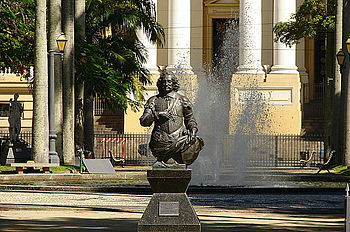Maurice of Nassau
Maurice of Nassau (1567-1625), Prince of Orange, stadholder of the Netherlands, was a leader of the Dutch Revolt against Spain.
The second son of William the Silent, he was born in Dillenburg Castle, Hesse-Nassau, now in West Germany, on Nov. 14, 1567. Educated at Heidelberg and Leiden, he succeeded his father, assassinated in 1584, as stadholder of Holland and Zeeland. By 1591, largely through the aid of Jan van Olden Barneveldt, who had been a strong supporter of William the Silent, Maurice became stadholder or lord of the northern, Protestant, Dutch half of the Netherlands. Maurice studied military science and was placed in charge of the armed forces. Working with Olden Barneveldt, head of the civil government, he set out to free the Netherlands from Spanish rule.
Maurice completely reorganized the Dutch army and its tactics and developed new methods of siege warfare. He implemented numerous tactical, technical, and logistical changes, and built a highly disciplined army that fought only two infantry battles but lay 30 sieges between 1588 and 1609. His military and naval victories enabled the Netherlands to conclude in 1609 a 12-year truce with Spain, which in practice meant the independence of the seven United Provinces.
Between 1591 and 1598 he liberated most of the larger Dutch cities, and with his brilliant victory over the Spanish at the Battle of Nieuport in 1600 he was recognized as one of Europe's outstanding military leaders. The war dragged on, however, and on Apr. 9, 1609, against Maurice's wishes, Olden Barneveldt negotiated a twelve-year truce with the Spanish. Enmity gradually developed between the two men, heightened by their opposite stands on the religious dispute between the Calvinists and Remonstrants.
Maurice, with the army behind him, finally gained the upper hand. In 1618 he arrested and condemned his rival to death on charges of treason, later proved to be unfounded. After Olden Barneveldt's death on the scaffold in 1619, Maurice's power was unchallenged, especially as he had become Prince of Orange on the death of his brother, Philip William, the year before. At the end of the twelve-year truce the struggle with Spain was renewed. Although Maurice repeated some of his early successes, the war proved a serious drain on his strength. He died at The Hague on Apr. 23, 1625.
Bibliography
- Darby, Graham. The Origins and Development of the Dutch Revolt (2001), 208pp online edition; also excerpt and text search
- Edmundson, Rev. George "The Dutch Republic," Cambridge Modern History (1905) vol 3 ch 19;
- Geyl, Pieter. The Revolt of the Netherlands: 1555-1609 (1958), still considered the definitive account of the Revolt online edition
- Haycock, R. G. "Prince Maurice (1567-1625) and the Dutch Contribution to the Art of War." Canadian Journal of Netherlandic Studies 1993 14(1): 53-65. Issn: 0225-0500
- Israel, Jonathan. The Dutch Republic: Its Rise, Greatness, and Fall, 1477-1806 (1995) a major synthesis; complete online edition; also excerpt and text search
- Motley, John Lothrop. History of the United Netherlands, 1584-1609 (4 vol., 1860–67) Gutenberg editions online
- Parker, Geoffrey. The Dutch Revolt (1977), 327pp
